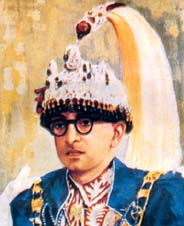Mahendra Bir Bikram Shah - 1955-1972
 King Mahendra (reigned 1955-72) vigorously sought to broaden the monarch's political base, but the Nepali National Congress succeeded in gaining some democratic reforms. Although the constitution was expected to be temporary pending the election of a Constituent Assembly and the preparation of a permanent organic law, King Mahendra was unable to resist the increasingly well-orchestrated political demands by the Nepali National Congress for a more democratic and representative government, and was forced to promulgate a new constitution.
King Mahendra (reigned 1955-72) vigorously sought to broaden the monarch's political base, but the Nepali National Congress succeeded in gaining some democratic reforms. Although the constitution was expected to be temporary pending the election of a Constituent Assembly and the preparation of a permanent organic law, King Mahendra was unable to resist the increasingly well-orchestrated political demands by the Nepali National Congress for a more democratic and representative government, and was forced to promulgate a new constitution.
The most significant aspect of the constitution of 1959 was that it was granted by the king rather than drawn up by elected representatives of the people as had been specified in the 1951 constitution. Although the constitution formally brought into being a democratically elected parliamentary system under a constitutional monarchy, the king retained ultimate sovereignty, even though the document itself did not explicitly grant this power.
The 1959 constitution, modeled on British and Indian constitutional custom, vested executive power in the king, who was advised and assisted by a Council of State (Raj Sabha) and a Council of Ministers (cabinet). The Council of State, which consisted of officers of Parliament, ministers ex officio, former ministers, and royal appointees, advised the monarch on legislation and handled the details of regency and succession in the event of his death or disability. The general direction and control of the government were entrusted to the Council of Ministers, headed by a prime minister required to command a majority in the lower house of Parliament, to which the council was collectively responsible.
The king was an integral part of the legislative arm of the government. Parliament was defined as consisting of the king; the House of Representatives, composed of 109 popularly elected members; and the Senate, composed of 36 members of whom half were elected by the house and half were nominated by the king. All bills approved by the two houses required the assent of the king to become law. The constitution granted the king wide latitude to nullify the parliamentary system. The king could suspend the operation of the cabinet and perform its functions himself if he determined that no person could command a majority in the house as prime minister. In the event of a breakdown of the parliamentary system or of any one of a number of emergency conditions, the king could suspend either or both houses of Parliament, assume their powers, and suspend the constitution in whole or part. In December 1960, King Mahendra invoked these emergency powers to dissolve the Nepali Congress Party government. The constitutional system that had prevailed before 1959 was then returned to operation.
By royal proclamation on December 16, 1962, King Mahendra announced a new constitution that radically reformed the 1959 constitution but also adopted many features of the Rana system. Known as the Panchayat Constitution, it was the fourth constitution in fifteen years.
The panchayat system was an institution of great antiquity. Historically, each caste group system of Nepal formed its own panchayat, or council of elders, a sociopolitical organization operational on a village level that could expand to include neighboring districts, or even function on a zonal basis. Although it could be argued that the panchayat system was adopted from India, King Mahendra had argued for its incorporation at the national level as an exponent of Nepalese culture a worthy and historically correct representation of cultural expression.
The 1962 constitution was based on some elements from other "guided democracy" constitutional experiments notably "Basic Democracy" in Pakistan, "Guided Democracy" in Indonesia, and the "Dominant Party System" in Egypt. The Panchayat Constitution not only codified the irrelevance of political parties, but also declared them illegal.
The 1962 constitution contained a stronger and more explicit statement of royal authority than did previous constitutions. Real power remained with the king, who was the sole source of authority and had the power not only to amend the constitution but also to suspend it by royal proclamation during emergencies. The Council of Ministers, selected from the members of the legislative (Rashtriya Panchayat, or National Panchayat), served as an advisory body to the king.
|
NEWSLETTER
|
| Join the GlobalSecurity.org mailing list |
|
|
|

